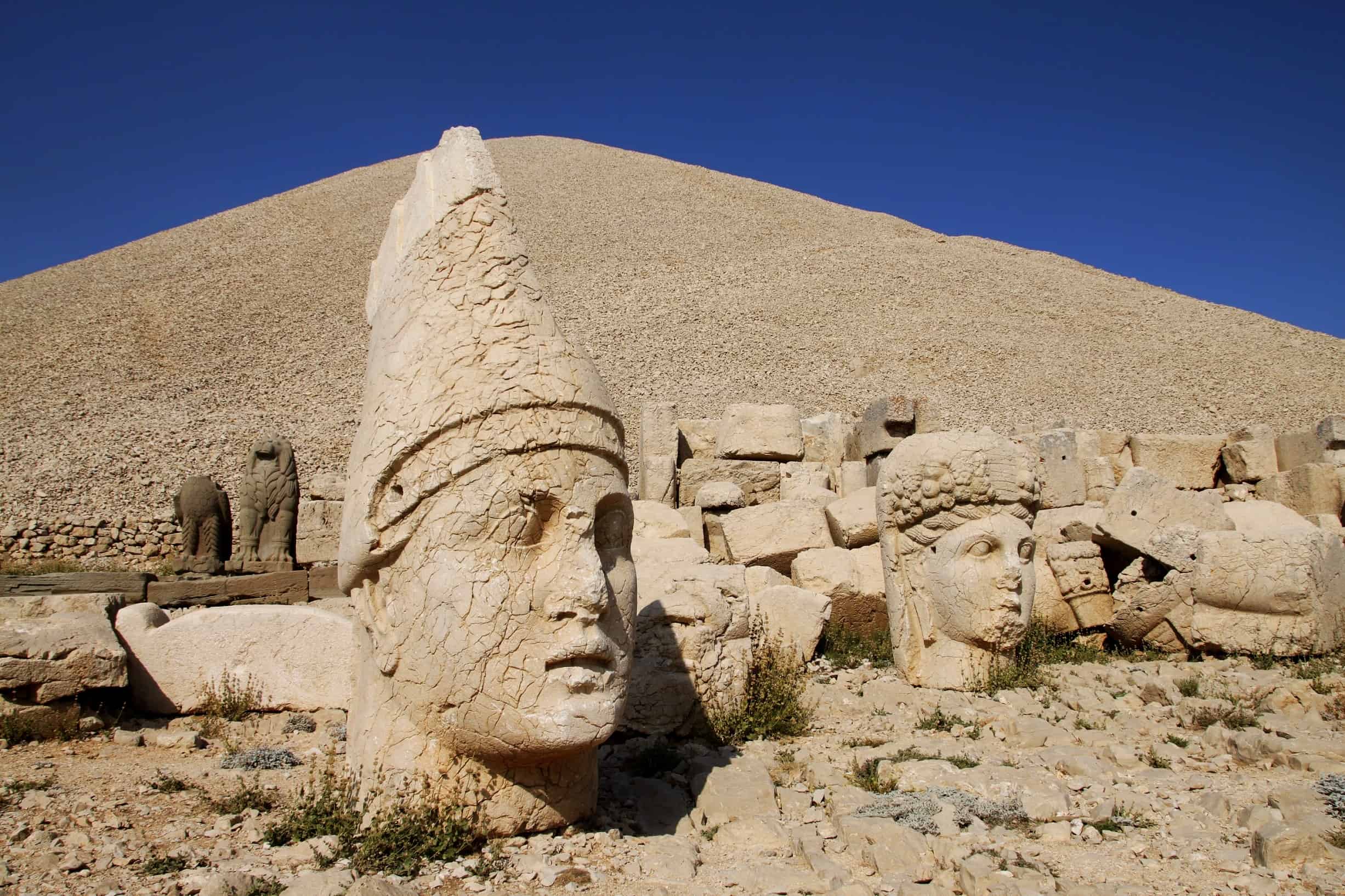Turkey offers a wealth of different kinds of destinations for travellers. From the dome and minaret-filled skyline of Istanbul to the beaches of Antalya or the misty mountains of the Eastern Black Sea, there is an adventure waiting in this crossroads of civilizations. However, some of its most fabulous attractions are not its modern cities or natural landscape, but the eclectic collection of Greek, Roman and Hittite ruins in the country.
Mount Nemrut
 https://www.flickr.com/photos/klearchos/
https://www.flickr.com/photos/klearchos/
Nemrut is a 2,134 meter high mountain in southeastern Turkey just outside the city of Adiyaman. While the tall mountain provides a beautiful viewpoint over the surrounding area from the summit, it is also home to the country's most fascinating ruins. In 62 BC, King Antiochus I Theos of Commagene built a tomb into Mount Nemrut that was flanked by two massive statues of himself, two lions, two eagles and various Greek and Persian Gods topping the mountain. Unfortunately, these statues have not weathered the tests of time well. The heads have topped off the statues when they collapsed and body parts are scattered throughout the mountain. The heads have, for the most part, been rounded up and returned to outside the tomb, which has made the main attraction watching the sunrise from the eastern terrace that paints the bodiless heads a beautiful hue of orange.
Library of Celsus
 https://www.flickr.com/photos/neilsingapore/
https://www.flickr.com/photos/neilsingapore/
The Library of Celsus lies in the town of Ephesus, which is itself a giant city full of ruins. In Roman times, Ephesus was one of the most prominent cities in the Roman Empire, famed for hosting the Temple of Artemis, one of the seven wonders of the ancient world. Unfortunately, the Temple of Artemis as well as a sizeable portion of the city was destroyed by a rioting mob led by the archbishop of Constantinople in 401 AD. While most of the city has fallen into disrepair, several structures still remain including the Great Theatre and the Library of Celsus. The library was built around 125 AD to store more than 12,000 scrolls of ancient knowledge and serve as the tomb of Celsus, governor of Asia. The scrolls have mostly been lost, but the exterior of the library remains intact for the millions of visitors that flock to Ephesus each year to see it.
Troy
 https://www.flickr.com/photos/72213316@N00/
https://www.flickr.com/photos/72213316@N00/
What more romantic ruin to visit than the fabled city of Troy? Due to the thorough destruction at the hands of the Greeks during the Trojan War, the ruins of Troy eluded many archeologists for some time. However, it has been determined that the city officially stood just outside of the current city of Canakkale. Unfortunately, the archeologists that discovered it, Heinrich Schliemann, also pilfered many of its treasures and destroyed several structures in his hasty dig. It has taken some time for other archeologists to undo the damage, but the city has come leaps and bounds over the years. Today, the ruins are a must for any history buff in Turkey, attracting hordes of visitors to what few buildings still stand. While some original Trojan structures can be found, including its famous wall, the site also has a unique mix of both Greek and Roman buildings that were built on the site later by the likes of Alexander the Great and Augustus.
Side
 https://www.flickr.com/photos/99664749@N08/
https://www.flickr.com/photos/99664749@N08/
Side, named for Sida, daughter of Danaus, is one of the oldest cities in Turkey. It was built in the 6th century BC and became renowned as a harbour town during the Hittite period that served as a huge trade city between countries in the eastern and western Mediterranean. As such an old city, Side has seen its fair share of famous historical figures pass through it, including Alexander the Great, numerous Roman emperors and Ptolemy pharaohs from Egypt. Today, the excavation of Side is still an ongoing process. Visitors can tour the pillars down by the sea, the well preserved walls and 2nd century BC Hellenistic gate as well as two seaside Greek temples dedicated to Athena and Apollo. It is a wonderful city for visitors to Turkey that both want to explore some ancient ruins as well as spent a day by the Mediterranean.
Kayakoy
 https://www.flickr.com/photos/sarah_c_murray/
https://www.flickr.com/photos/sarah_c_murray/
The small village of Kayakoy is Turkey's most recent set of ruins. Up until 1923, this small town was home to several thousand people, but today it is a ghost town filled with deserted houses, shops, schools and churches. Although only recently abandoned, the town dates back to the 3rd century BC under the Greek name of Carmylessus which served as a valuable trading city until 1100 AD. Into the modern age, Kayakoy was a little town inhabited by craftsmen and farmers that were all Greek in origin. It served as one of the few cities where Greek and Turkish citizens lived side by side in relative peace. Unfortunately, after the Greco-Turkish War of 1919-1922, all of the Greek citizens of the town were rounded up and forced to resettle back in Greece in a town called Nea Levissi. With most of their friends and neighbours gone, the Turkish residents also moved on from Kayakoy, leaving this 20th century town a series of slowly dilapidating ruins and a play place for tourists.


